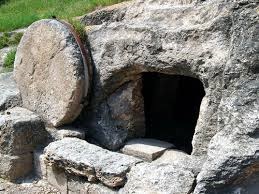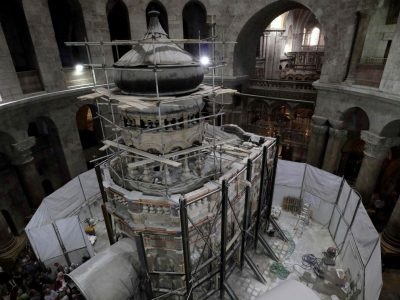For the first time in hundreds of years, the marble stone above the tomb of Jesus Christ in the Church of the Holy Sepulchre in Jerusalem was lifted as part of historic renovations at the holy site.
According to the Christian faith, after his crucifixion, Christ’s body was laid on a shelf that was placed within a cave, now covered by a structure called the Aedicule – a small chapel which will also undergo renovations alongside the tomb itself, which Christians hold to be empty following Jesus’ resurrection.
The marble stone covering the empty tomb was lifted as part of the attempt to renovate the tomb itself and the Aedicule. This is most likely the first time since the 16th century that the huge marble stone covering the tomb has been moved.
The renovation of the structure began a number of months ago after a historic agreement was reached between the Eastern Orthodox, Roman Catholic, and Armenian churches – the three main churches sharing the structure according to the status quo.
The last time the actual structure was renovated was by the British in 1947, when thick metal cables were put in place to support the Aedicule, but the actual tomb stone wasn’t touched. Since then, no substantial renovation was conducted on the structure and its condition has deteriorated, a situation which was further exacerbated by the inability of the three churches to agree on a course of action.
A year and a half ago, antiques’ officials warned about the structure’s state and the police decided to close the site to pilgrims for a number of hours, fearing additional damage to the site. The closure prompted anger and protest, with church officials claiming that the police took the decision without conferring with them or informing them in advance.
Greek preservation experts work to strengthen the Adicule surrounding the Tomb of Jesus, where his body is believed to have been laid, as part of conservation work done by the Greek team in Jerusalem
Greek preservation experts work to strengthen the Adicule surrounding the Tomb of Jesus, where his body is believed to have been laid, as part of conservation work done by the Greek team in Jerusalem
In wake of the incident, representatives of the three churches involved in the running of the site began holding negotiations and some six months ago they reached an agreement. According to the deal, the renovation would be led by the National Technical University of Athens under the oversight Greek Orthodox Patriarchate and the Custody of the Holy Land – an order of the Roman Catholic Church that is the site’s custodian.
The renovation is substantial and includes dismantling the metal cables put in place by the British, and putting large metal rods inside the columns and injecting advanced cement-like materials inside the cracks and crevices in the stones to reinforce them. Part of the structure itself will also be taken apart to be restored independently before it is placed back within the holy site.
Last Wednesday, for the first time in hundreds of years, the actual stone above the interior tomb was lifted, exposing the holy site to about a billion Christians across the globe.
The marble blocks were placed above the grave some 500 years ago. Underneath them, workers discovered another marble block marked with a cross and dating back to the 12 century crusaders, as well as building materials used at the time the upper marble slab was placed above the tomb.
As far as is currently known, the workers did not reach the surface of the tomb shelf itself, which was where Jesus’ body was placed after the crucifixion and before he ascended to heaven, according to the Christian faith. After the tomb area was renovated, the marble block was put back in its place and on Saturday the site was reopened for visitors.
Prof. Joseph Patrich from the Hebrew University’s Institute of Archaeology said that he was amazed that restorators were given authority to lift the stone to begin with: “It very much surprised me that a secular activity was permitted in such a sensitive and holy site, but this renovation is ‘holy work’,” he said.
Last week, the project’s chief scientific supervisor, Prof. Antonia Moropoulou spoke at a Jerusalem conference organized by Israel’s Antiques Authority. The talk was attended by the Patriarch of Jerusalem, Theophilos III.
HAARETZ















No comments :
Post a Comment